
OBI Setup
Note: This topic applies to OBI having licenses OPB_<version number> OBI Enterprise (OBIEE - Multiple Properties), or OPI_BUIP_<version number> OBI Standard (Single) using OLAP technology and data cubes. This topic does not apply to S&C Advanced Reporting whose data is accessed directly from OPERA tables via OLTP. For S&C Advanced Reporting, see S&C Advanced Reporting Subject Areas or S&C Advanced Reporting Setup.
Before you can view Opera data within the OPERA Business Intelligence (OBI) application, you must first collect specific data from the OPERA database and store it in OBI data cubes. The OPERA Business Intelligence Setup process lets you define what OBI data cubes and cube dimensions you want used to gather OPERA data that will, in turn, be used for your queries and analysis. For example, you can select the Company BI Cube for gathering information about the companies that provide maximum revenue. You can then select the company dimensions you want used to compute and store data, such as company account type, company name, market, rate, room type, source, and so on.
Once a cube has been built with OPERA data, it stores the precalculated, summarized, and compressed data which OBI accesses for multidimensional viewing through the OBI Dashboard. With OPERA data in prebuilt cubes, data retrieval speed and accuracy is assured. The OBI setup process defines the timeframe for the data from which you want to initially build the cube, the frequency in which you want the OBI data cubes to be refreshed and maintained, and provides build and error logs, the opportunity to stop a job, and other options.
For more information about OPERA Business Intelligence, see About OPERA Business Intelligence.
Note: For information on setting datamart views and BI reports for central currency, refer to the help topic Setting Central Currency Views.
Access the OPERA Business Intelligence Setup screen to begin the OBI data cube setup process by selecting Configuration>Setup>OPERA Business Intelligence Setup. The OPERA Business Intelligence Setup Screen appears.
To access this screen, users must have the permission OBI>OBI Setup - Business Intelligence Setup.
Once you have activated the OBI license, and have been given the appropriate permissions to access the OBI Setup functionality:
This is the first screen that appears when you access the OPERA Business Intelligence Setup process. Initially (when the license code has just been activated), this screen displays all the OBI cubes available as marked inactive, Active (N). As you set up which cubes you want to use in your BI reports, you will make them Active (Y). Then, you will access the OPERA Scheduler and schedule the Active cubes to be built.
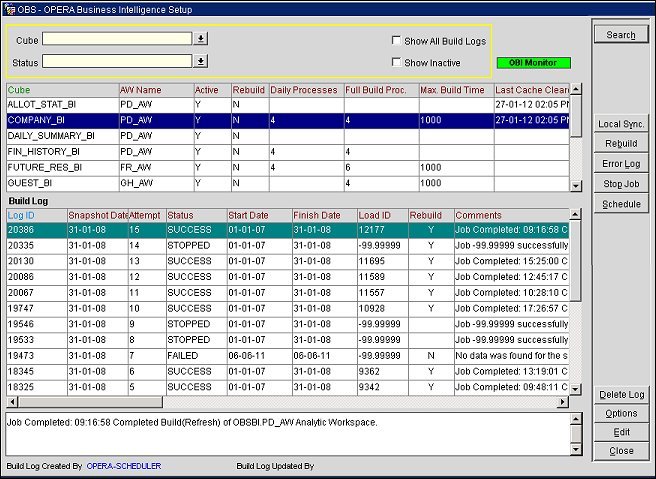
Cube. Select the down arrow to choose specific Cubes to view.
Status. Select the down arrow to choose specific Build Log statuses.
Show All Build Logs. Select to display all of the Build Logs.
Show Inactive. Select to display all of the OBI Cubes, active and inactive.
Cube. Name of the data cube as it appears in the OBI setup screens, the OPERA Scheduler, and various other screens throughout OPERA.
AW Name. Name of the cube in the Analytic Workspace, which is the internal storage location of the cube. The cube is either stored in the OPERA schema or in a different schema appended to the OPERA schema.
Active. Identifies whether or not the cube is being used by the OBI application (N=Inactive, Y=Active).
Rebuild. Indicates if the cube is scheduled to be rebuilt, using the Rebuild functionality. Specific properties, time periods, and dimensions will be recalculated, overwritten or added to the previous build.
Daily Processors. Indicates how many CPU processors you want allocated to the cube when it is being built or updated during the scheduled daily maintenance process. The default amount will be assessed and assigned by Oracle if nothing is entered.
Full Build Process. Indicates how many CPU processors you want allocated to the cube when it is being built during the scheduled full build process. The default amount will be assessed and assigned by Oracle if nothing is entered.
Max. Build Time. Indicates the amount of minutes allowed to lapse if no data is actually updating the cube (due to a possible error), before the process stops and shuts down. 180 minutes is the default time. This prevents the process from running forever if no data is actually being added. Otherwise, when the cube is being built or updated with data, there is no time limit to the process; it will run until successfully completed.
Last Cache Cleared Time. Displays the date and time when the cache for the cube was last cleared. The cache should be cleared frequently to ensure that BI reports have consistent data. After viewing this date and time, you may choose to clear the cache for the individual cube or for all cubes by selecting the Options>Clear Cache buttons. See OBI Setup Options below.
The Build Log shows the status of the highlighted cube as it is in process being built/updated by the OPERA Scheduler. This can help in troubleshooting or knowing when the data is available in BI. This information in the Build Log gets updated every 10 minutes. Once the Status is Completed, the data is available for viewing in OPERA BI.
Snapshot Date. Date when the cube was last built.
Attempt. The number of times the process was started.
Status. The status of the build/update for this cube. The statuses include:
Start Date. Date when the build/update started.
Finish Date. Date when the build/update finished.
Load ID. System-assigned ID for that build. The ID can also be referenced in the Error Log.
Comments. System comments about the build process.
Business Date. Business date in OPERA for the data used to build the cube.
Processed Row. The number of rows in the report that were processed.
Rejected Row. The number of rows in the report that were rejected.
Build Start Time. The time when the build process began.
Build Completed. The time when the build ended.
Build Time. The amount of time the last build took to build.
Insert Date. The date the build data was initially inserted in OBI.
Update Date. The date the initial data was updated.
Dimension. The dimension rebuilt, or the dimension deleted when deleting a specific property.
Log ID. The unique identifier for this build record.
Clean Dimension. Used when rebuilding dimensions and when deleting a specific property.
Clean Attribute. Used when rebuilding dimensions and when deleting a specific property.
Command Type. Type of job being requested/performed (for internal use). Can be CUBE, DIM or INTERNAL.
Properties. List of properties being affected by the job.
Local Sync. Select this button to manually sync PMS tables with the local tables in OBI. Selection of this button opens the OBI Local Synchronization Utility. This utility allows you to manually populate data from the OPERA schema into local tables in the OBI schema. This is useful when there are configuration changes in PMS, such as new rate codes.
Rebuild. Select this button to set up specific date ranges, properties, and other dimensions for the highlighted cube to be rebuilt since the last build. The previous build data will be overwritten or have the additional data added. The Rebuild Cube Manually screen appears. See Rebuilding the Cube Manually below. This Rebuild process can be activated directly from the OBI Setup Screen and will still be processed through the OPERA Scheduler.
Error Log. Select this button to view process errors that may have occurred during the build. See OBI Errors below.
Stop Job. Stops the highlighted cube build job.
Schedule. Opens the OPERA Scheduler screen where you can schedule the highlighted cube build. When OBI cubes are built for the first time, or completely rebuilt after an upgrade, the application setting OBI>Settings>OBI Start Year can be activated to select a specific year from when data will be used to build the cube. All cubes, except Reservation Pace Cube, can use this setting. The start date will be the 1st day of January of the year specified in this setting. If this application setting is not set, the cube activated to be (re)built through the OPERA Scheduler takes data from the 1st of January of the current year, minus 2 years (e.g., if the business date is 12-Jun-08 and the parameter is blank, the start date will be 01-Jan-06).
Note: You can also schedule the active BI Cube jobs from the Scheduler screen by selecting the Schedule button (on the Scheduler screen).
Delete Log. Select this button to delete the highlighted build log from the system. Please note that this function must not be used if the job is currently running.
Options. Select this button to open the OBI Setup Options screen where you can select to stop all jobs, stop the OBI Monitor, assign OBI keywords, and perform other tasks. See OBI Setup Options below.
Edit. Select this button to open the OBI Setup screen. At this screen you can select the parameters and dimensions you want used to build the cube. See Edit OBI Setup Screen, below.
The header in this screen identifies the cube being set up, the Analytic Workspace (AW) name, and the name of the OPERA schema.
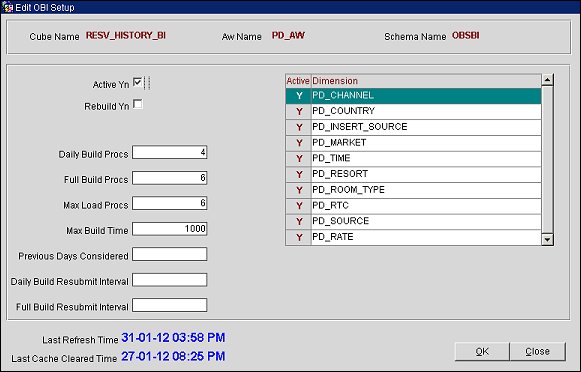
Active Yn. Select this check box to make the data cube active; this means that the cube and its parameters and dimensions will be sent to the OPERA Scheduler to be built/maintained and the data used in OBI.
Rebuild Yn. Select this check box to indicate that the cube will be rebuilt (either manually by selecting the Rebuild button or automatically by scheduling a build job). When this option is selected and the cube is scheduled for rebuild, all dimensions will be loaded with the SYNCH option, which will remove rows from the cube that no longer exist. This option is useful when dimensions have been changed or deleted as these rows will be removed from the cube during the rebuild.
Forecast Yn. This check box is available for the Company and Travel Agent Cubes. Selecting this check box will include forecast data in the cube. When not selected, forecast data will not be included in the cube; only historical data will be included.
Daily Build Procs. Enter how many CPU processors you want allocated to the cube when it is being built or updated during the scheduled daily maintenance process. The default amount will be assessed and assigned by Oracle if nothing is entered.
Full Build Procs. Enter how many CPU processors you want allocated to the cube when it is being built during the scheduled full build process. The default amount will be assessed and assigned by Oracle if nothing is entered.
Max Build Time. Enter the maximum interval in minutes where if a cube is not updated with data during the build process, the job will stop. In other words, if there are no new entries for this entered amount of time, the job is killed. The default is 180 minutes.
Previous Days Considered. Enter the number of days prior to the ending date of the last build or last update process (Snapshot date), that you want the system to go back and begin to gather data. This ensures that all data is considered during the maintenance process for the next build.
Daily Build Resubmit Interval. Enter the time interval to automatically resubmit Failed Daily Build jobs. This does not apply to jobs that fail because of “No Data Found.”
Full Build Resubmit Interval. Enter the time interval to automatically resubmit Failed Full Build jobs. This does not apply to jobs that fail because of “No Data Found.”
Last Refresh Time. Date and time that the cube parameters and dimensions were last updated.
Last Cache Cleared Time. Date and time that the cube's cache was last cleared from the BI Server. For more information on clearing the cache, see OBI Setup Options/Clear Cache below.
Determine what dimensions you want included in the cube, considering your specific needs for OBI reports and how much space and time you want to allow for building the cube. Double-click on the dimension to make it active or inactive. When Active, the data from OPERA will be gathered, summarized, and stored as scheduled through the OPERA Scheduler for this cube.
The OBI Errors screen appears when the Error Log button is selected from the OPERA Business Intelligence Setup screen. The system errors that have occurred during the build display.
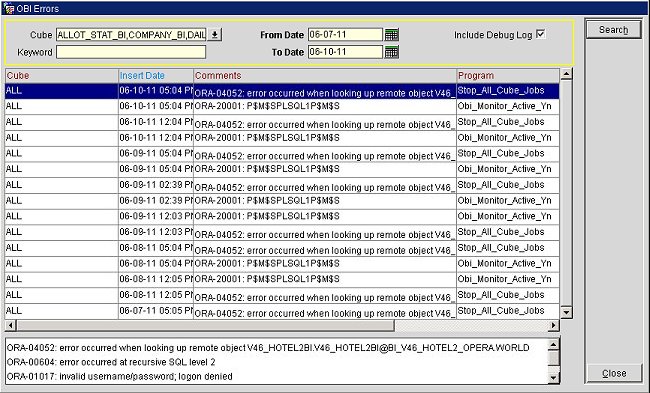
Cube. By default, the errors will include all Cubes. But select the down arrow to specify one or more specific cubes to display the errors for.
Keyword. Enter a keyword to search for the error message for. This can include a partial comment, program name, etc.
From Date. As this field is Mandatory, enter the begin date or select the calendar button to choose the date.
To Date. As this field is Mandatory, enter the to date or select the calendar button to choose the date.
Note: The From Date and To Date cannot be more than a 7 day range. If dates are entered that are more than 7 Days, then an error message is displayed to notify the user about the conflict. The following is the message that is displayed, "Date Range cannot be more than 7 days".
Include Debug Log. Available when the OBI>OBI Debug application function is set to Y, select the check box to include the Debug Log in the error list. This log will display specific details in the actual building of the OBI Cubes.
The information includes the name of the cube that encountered the error, the date the error occurred, brief description of the error, the program that caused the error (i.e. Oracle), the cause of the error (action), the dimension where the error occurred, and the Load ID. The most recent errors are displayed on the top of the list.
The Rebuild Cube Manually screen appears after the Rebuild button has been selected. You have flexibility to select specific properties (in a multiple-property environment) and a timeframe in which to build new data for the highlighted, previously built cube. Dimensions that will be used for the rebuild process will have to be activated in the Edit OBI Setup screen prior to this process.
Note: The Reservation Pace Cube's manual rebuild processing performance has been enhanced. During the Rebuild Cube Manually process in a multi-property environment, the system only uploads data from the selected properties from the OPERA Database to the Fact Table. This reduces the amount of data as well as the time it takes for uploading. Prior to this enhancement, the system would upload all properties' data in the environment from the OPERA Database to the Fact Table and then filter the selected properties' data for the Reservation Pace Cube's build job.
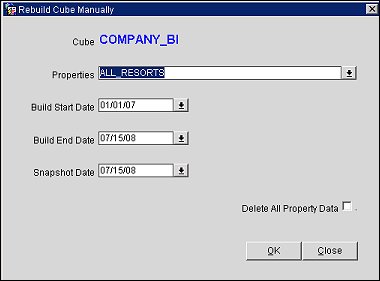
Cube. The name of the cube you have highlighted on the OPERA Business Intelligence Setup screen to rebuild appears in the header.
Properties. In a multi-property environment, select the LOV to mark the properties whose data you want to use to rebuild the cube.
Build Start Date/Build End Date. Select the timeframe for the data you want to use for the new rebuild (Build Start Date and Build End Date). This will be prepopulated with default values.
Snapshot Date. Select the Snapshot Date (date of the build you are going to overwrite), if desired. Otherwise, a default date of today's date is entered.
Delete All Property Data. Select this check box if you want to delete all the data for the selected properties. This will build all of the data from scratch as opposed to adding to the existing full build.
OK. Select OK and accept the confirmation. A job name will be displayed, which is the Cube name followed by a sequence number. This is the OPERA Scheduler job which is building the cube and can be found in the OPERA Scheduler screen. Double-click on the Load ID column of the Status grid to see the progress of the Build job.
Snapshot Date. Enter the date of the build (snapshot) you want to use as the basis.
This screen appears after the Options button has been selected from the OPERA Business Intelligence Setup Screen.
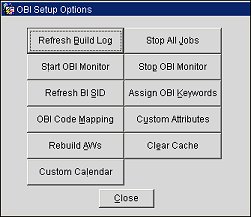
The following options are available:
Refresh Build Log. Selecting this button immediately refreshes the Build Log.
Stop All Jobs. Stops all jobs through the OPERA Scheduler. You may want this option to free up system resources.
Start OBI Monitor. Select this button to start the OBI Monitor (monitoring and managing communications between OBI and OPERA). The Green status lamp displays on the OPERA Business Intelligence Setup screen.
Stop OBI Monitor. Select this button to stop the OBI Monitor. The Red status lamp displays on the OPERA Business Intelligence Setup screen.
Refresh BI SID. This may be selected if changes have been made to the cube parameters and dimensions and you want to synchronize data.
Assign OBI Keywords. Select this button to display the Profile Distribute screen. See Assign OBI Keywords below.
OBI Code Mapping. Select this button to display the OPERA BI Code Mapping for BI Reporting screen where users can consolidate and create custom groupings for existing codes. See OBI Code Mapping for more information.
Custom Attributes. This option is used when the OPI_<version number> OBI Enterprise (Multiple Properties - OBIEE) license code is active. Select this button to open the OPERA BI Custom Attributes Setup screen. Here you can begin to set up a maximum of 10 customized attributes to be displayed in BI cube reports. See OBI Custom Attributes for more information.
Rebuild AWs. This button is available when the user has the permission OBI>OBI AW CUBE WITH FULL REBUILD DROP. The application parameter OBI>Drop Cube with Full Rebuild must also be set to Y. If the user does not have this permission, the button is not visible.
Assuming the button is visible,select the Rebuild AWs button to begin the process of creating a new build for Analytic Workspaces (AWs). This process is necessary to reduce the excessive use of disk space caused by the system consistently adding more data to the OLAP cubes during incremental builds. Users select one or more AWs and then schedule the full build of one of the associated cubes through the OPERA Scheduler. During the build, the system will drop the existing AW and recreate a new one. All data from the associated cubes within the AW are removed and rebuilt, freeing up space.
Note: There are no guidelines as to when to rebuild AWs, as it depends on your disk size, hardware, and how much space you can afford to allocate. The following query can be used to check how much space is being used by each AW. If the AW space appears to be too large, then schedule the rebuild.
select dbal.owner||'.'||substr(dbal.table_name,4) awname,
round(sum(dbas.bytes)/1024/1024) as mb, dbas.tablespace_name
from dba_lobs dbal, dba_segments dbas
where dbal.column_name = 'AWLOB' and dbal.segment_name = dbas.segment_name
group by dbal.owner, dbal.table_name, dbas.tablespace_name
order by dbal.owner, dbal.table_name;
When the Rebuild AW button is selected, the Analytic Workspace screen appears. A list of AWs appear in the multi-select screen.

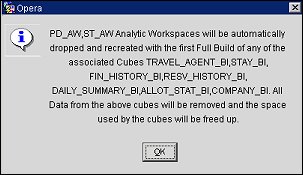
Clear Cache. Select this option to clear the BI Server's cache for one or more cubes. The cache should be cleared frequently to ensure that BI reports have consistent data. You can view when the cube's cache was last cleared on the OPERA Business Intelligence Setup top grid and on the Edit OBI Setup screen. After selecting Clear Cache, a multi-select screen appears where you can select the cube(s) whose cache you want to clear. Upon completion, you will receive a message Cache Cleared Successfully.
OBI Import Status. This option will be available after an import job is scheduled. Select this option to open the OPERA BI Import Status screen (see below) for the import job. From the OPERA BI Import Status screen, you can select the View button to view the status of the imported data. On the OPERA BI Import Status screen, there are options to filter your search results by Datamart, property and date.
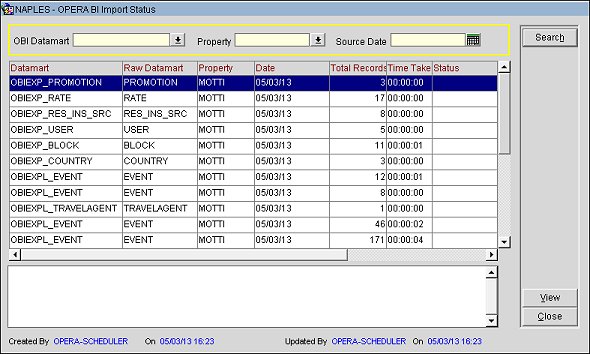
Custom Calendar. Select to create custom calendars in OBI for your OBI cubes. See OBI Custom Calendar for more information.
OBI keywords can be assigned to important Companies, Travel Agents, and Guests so that these profiles and keywords will be included in BI cubes for analysis. When the OBI license code is active: OPB_<version number> OBI Enterprise (Multiple Properties), or OPI_BUIP_<version number> OBI Standard (Single) users can access the Profile Distribute screen by selecting the OPERA Business Intelligence Setup>Options>Assign OBI Keywords menu option.
Using the Profile Distribute screen, OBI users can create new OBI keywords or delete existing OBI keyword criteria for the profile types of Company, Travel Agent or Individual. The keywords are assigned to the profiles and accounts based on the filter and criteria you selected. This enables the accounts and profiles to appear in specific OBI reports. You will need to build (or rebuild) the cubes after these new OBI keywords are assigned. Then, you will need to schedule the BI - Cube Maintenance so that the profiles and keywords are constantly updated for the BI cube dimensions.
Note: When a Master Company Profile has subsidiary companies, and the subsidiaries have been assigned a keyword, the Master Company is also assigned the keyword. The Master Company appears on subsequent profile screens for identification. When you select Preview, you will only see the Master Company listed on the Profile Search screen. When you complete the BI- Company OBI Keywords job, you will see that the Master Company has the keyword applied. This implies that the subsidiaries also have the keywords assigned.
Creating and deleting OBI keywords on the Distribute Profile screen is controlled by the permission: PROFILES>MAINTAIN OBI KEYWORD.
You can search for profiles having OBI keywords already assigned to them by accessing the Profile Search screen. In the Keyword field, enter the prefix of the OBI_ and the keyword.
See Also